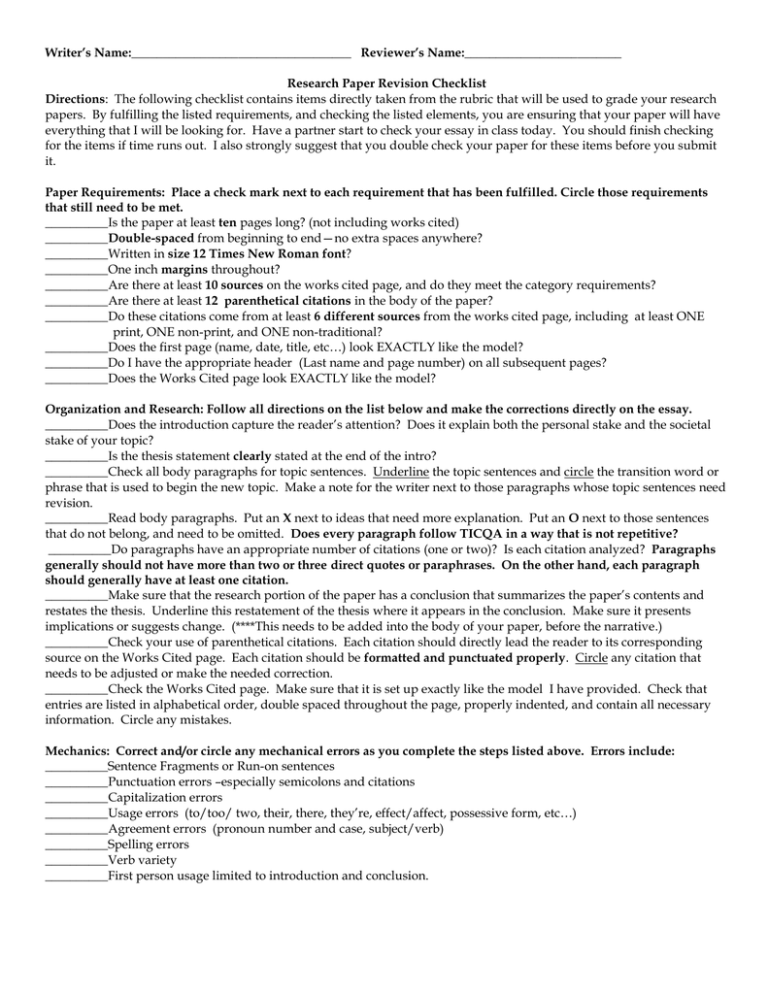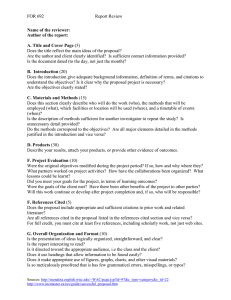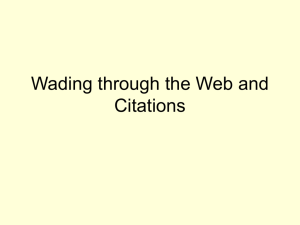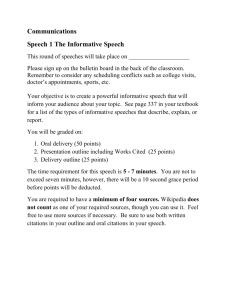Writer’s Name:___________________________________ Reviewer’s Name:_________________________ Research Paper Revision Checklist
advertisement

Writer’s Name:___________________________________ Reviewer’s Name:_________________________ Research Paper Revision Checklist Directions: The following checklist contains items directly taken from the rubric that will be used to grade your research papers. By fulfilling the listed requirements, and checking the listed elements, you are ensuring that your paper will have everything that I will be looking for. Have a partner start to check your essay in class today. You should finish checking for the items if time runs out. I also strongly suggest that you double check your paper for these items before you submit it. Paper Requirements: Place a check mark next to each requirement that has been fulfilled. Circle those requirements that still need to be met. __________Is the paper at least ten pages long? (not including works cited) __________Double-spaced from beginning to end—no extra spaces anywhere? __________Written in size 12 Times New Roman font? __________One inch margins throughout? __________Are there at least 10 sources on the works cited page, and do they meet the category requirements? __________Are there at least 12 parenthetical citations in the body of the paper? __________Do these citations come from at least 6 different sources from the works cited page, including at least ONE print, ONE non-print, and ONE non-traditional? __________Does the first page (name, date, title, etc…) look EXACTLY like the model? __________Do I have the appropriate header (Last name and page number) on all subsequent pages? __________Does the Works Cited page look EXACTLY like the model? Organization and Research: Follow all directions on the list below and make the corrections directly on the essay. __________Does the introduction capture the reader’s attention? Does it explain both the personal stake and the societal stake of your topic? __________Is the thesis statement clearly stated at the end of the intro? __________Check all body paragraphs for topic sentences. Underline the topic sentences and circle the transition word or phrase that is used to begin the new topic. Make a note for the writer next to those paragraphs whose topic sentences need revision. __________Read body paragraphs. Put an X next to ideas that need more explanation. Put an O next to those sentences that do not belong, and need to be omitted. Does every paragraph follow TICQA in a way that is not repetitive? __________Do paragraphs have an appropriate number of citations (one or two)? Is each citation analyzed? Paragraphs generally should not have more than two or three direct quotes or paraphrases. On the other hand, each paragraph should generally have at least one citation. __________Make sure that the research portion of the paper has a conclusion that summarizes the paper’s contents and restates the thesis. Underline this restatement of the thesis where it appears in the conclusion. Make sure it presents implications or suggests change. (****This needs to be added into the body of your paper, before the narrative.) __________Check your use of parenthetical citations. Each citation should directly lead the reader to its corresponding source on the Works Cited page. Each citation should be formatted and punctuated properly. Circle any citation that needs to be adjusted or make the needed correction. __________Check the Works Cited page. Make sure that it is set up exactly like the model I have provided. Check that entries are listed in alphabetical order, double spaced throughout the page, properly indented, and contain all necessary information. Circle any mistakes. Mechanics: Correct and/or circle any mechanical errors as you complete the steps listed above. Errors include: __________Sentence Fragments or Run-on sentences __________Punctuation errors –especially semicolons and citations __________Capitalization errors __________Usage errors (to/too/ two, their, there, they’re, effect/affect, possessive form, etc…) __________Agreement errors (pronoun number and case, subject/verb) __________Spelling errors __________Verb variety __________First person usage limited to introduction and conclusion. Some miscellany: 1. Remember to micro-manage your Works Cited page. You need to make it look exactly like the sample. It also must have at least ten sources, as specified. 2. Make sure that you have referred to at least six of those sources in the actual paper, with at least one print, one non-print, and one non-traditional. 3. Some grammatical concerns I have accumulated, based on your rough drafts. Numbers under one hundred are written out as words; numbers 100 and up are written as numbers. Refer to people by first and last name the first time you reference them; thereafter just use the last name. Check your pronoun agreement. Don’t say, for example, “When a person wants to try something new, they should consider yoga.” Make sure your titles properly marked: Articles and short pieces get “quotation marks”; Long books get italicized. Refer to people as “who” or “whom” not “that” Check your being verbs: use a variety of strong action verbs. Check you sentence types: use a variety of sentence lengths and sentence beginnings 4. Do not string quotations together, without providing some analysis in between them. 5. Too many citations are undesirable. 6. Too few citations are undesirable. 7. LONG quotes are handled in a special way. Look at OWL or the MLA Handbook. 8. Consecutive quotes from the same author are handled in a special way. Look at OWL or the MLA Handbook. 9. Make sure you use transition words to move your reader through your paper. 10. You may use headings at the beginning of new categories, if you wish. 11. Quotations that are longer than four lines need to be indented. Check your MLA handbook for instructions. 12. If you have consecutive citations coming from the same source, you must adapt the way you cite. Refer to your MLA handbook for instructions.




